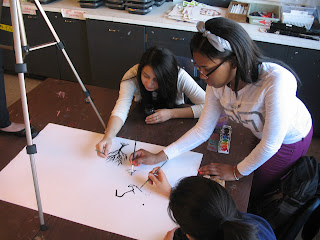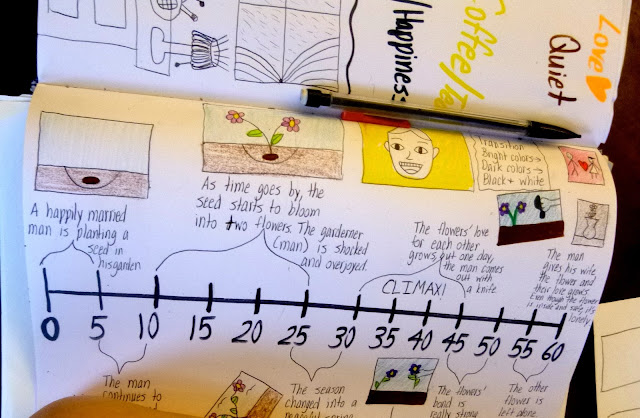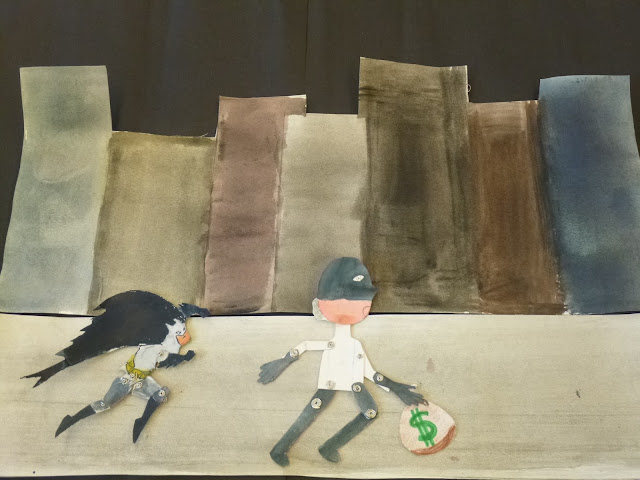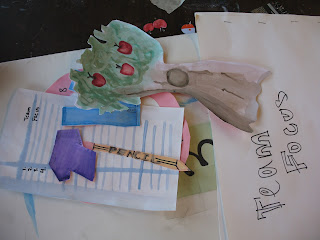Before I begin posting work created by the 2nd batch of wonderful students I am blessed to have at Lane this year, I thought I should post about the animation project my 1st wonderful batch of students worked on at the end of the last school year.
This project was spurred and funded by an Oppenheimer grant I received which allowed me to purchase 8 cameras and 8 tripods. The vision I had was that my students would collaborate with music students to create inter-departmental, collaborative works of art.
To begin,
Ms. Kulich and Mr. Flygt's music students created original music compositions, either by layering sounds in Garage Band or by recording their own instruments. Art students
utilized the tripods and cameras purchased with the Oppenheimer Grant that we
received, to create 40 different stop-motion animations. We were able to edit these animations
using IMovie, and showcase them at a screening that all of the Lane Tech staff
and parents were invited to.
Throughout the project, my students learned about
inter-departmental collaboration, teamwork, the ins and outs of stop-motion
with a camera, as well as the basics of IMovie software. There was a whole lot of problem solving and creativity involved!
And now for some images to highlight each aspect of the process!
Before we got started on the finished product,
my students explored
stop-motion animation without a plan, spontaneously.
Day 1: they took pictures of toys and slowly moved them around on
a surface. This helped them gain an understanding of how the cameras and
tripods worked, and how to create the illusion of fluid movement through a
sequence of small incremental movements.
Day 2: They animated paper cut-outs and collage elements on a surface.

Day 3: they animated using watercolor and ink using an additive process where lines and imagery magically "appeared" and grew.
 |
| students make a volcano explode, very very slowly! |


 Next, my students received original music compositions created by the music students. Each group listened to their assigned song and brainstormed what the song made them think about. They then came up with a loose narrative, and created a timeline and a storyboard as a group. The storyboard showed what action would take place for each second of the animation. The students would have to take 10 photographs for every second! 600 photographs for each song!
Next, my students received original music compositions created by the music students. Each group listened to their assigned song and brainstormed what the song made them think about. They then came up with a loose narrative, and created a timeline and a storyboard as a group. The storyboard showed what action would take place for each second of the animation. The students would have to take 10 photographs for every second! 600 photographs for each song!


 Next, they created divided up the labor and created the characters and the sets for their minute-long animation. To do this they had full range of the studio space, and could use any materials that suited their needs. Characters and sets ended up being created with watercolor, collage, 3-D objects such as yarn balls, drawn puppets, toys and more.
Next, they created divided up the labor and created the characters and the sets for their minute-long animation. To do this they had full range of the studio space, and could use any materials that suited their needs. Characters and sets ended up being created with watercolor, collage, 3-D objects such as yarn balls, drawn puppets, toys and more.










 After the sets and characters were mostly ready, the students began working as a team to take the over 600 photographs that were needed to animate the original songs. The students took turns being animators and camera operators. It was a painstaking and tedious process which took the students over 5 days of photographing. The animators had to move the characters very incrementally for each photo, not knowing exactly what the movement would look like once we got into the lab. After each photo session, the students gathered around the tiny LCD display on the camera, held down the back play button, and saw a slower version of what their photos would look like, strung together in motion.
After the sets and characters were mostly ready, the students began working as a team to take the over 600 photographs that were needed to animate the original songs. The students took turns being animators and camera operators. It was a painstaking and tedious process which took the students over 5 days of photographing. The animators had to move the characters very incrementally for each photo, not knowing exactly what the movement would look like once we got into the lab. After each photo session, the students gathered around the tiny LCD display on the camera, held down the back play button, and saw a slower version of what their photos would look like, strung together in motion.




Finally, after they reached the end of their storyboard and thought they had enough photos, we all worked in the MAC lab at school to use IMovie. Using the free IMovie software, the students worked for 3 days to import and edit their photos, add effects, align their music, and design their credits.
In my opinion, the animations that the students ended up creating are absolutely stunning. They are responsive to the music, very unique, creative and in many cases quite professional looking. I know the students did not love this animation process because it is so tedious to take all of those photos, however, I believe they were really proud of the end result once we watched the animations in the auditorium.
Here is a link to almost all of the final student animations on one reel.
http://youtu.be/5fgEmk22kE8









